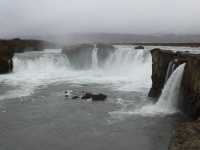 On June 5th-15th, Michael Twomey (English, Dana Professor) and Steven Hartman (English, 1987) taught environmental humanities in the Svartárkot Culture-Nature Program based in Kiðagil, Bárðardalur, Northern Iceland. The course, titled “Understanding the Human Dimensions of Long-Term Environmental Change: Transformations of Iceland From the Viking Era Through the Late Medieval Period (CE 850-1500),” brought an international faculty in literary criticism, archeology, environmental history, visual landscape studies, historical climatology, and ecology together with 10 graduate and post-graduate students from England, Greenland, Japan, Sweden, and the USA.
On June 5th-15th, Michael Twomey (English, Dana Professor) and Steven Hartman (English, 1987) taught environmental humanities in the Svartárkot Culture-Nature Program based in Kiðagil, Bárðardalur, Northern Iceland. The course, titled “Understanding the Human Dimensions of Long-Term Environmental Change: Transformations of Iceland From the Viking Era Through the Late Medieval Period (CE 850-1500),” brought an international faculty in literary criticism, archeology, environmental history, visual landscape studies, historical climatology, and ecology together with 10 graduate and post-graduate students from England, Greenland, Japan, Sweden, and the USA.
Steven, who is Professor and Chair of English Literature in the Department of Humanities at Mid Sweden University, presented a documentary on the environmental humanities co-produced in the Bifrost project series. He also led a roundtable discussion on the methodological benefits and challenges of integrated research drawing upon the disciplines of literature, history, and archeology, geography, and digital humanities; and he conducted interviews with visiting researchers for a new documentary in the Bifrost series focused on climate change. Steven has been one of the principal organizers of the Svartárkot course in the program’s past two iterations.
Michael gave two formal lectures and shared in a panel discussion about an Icelandic saga. In addition, he served as a session moderator and as a mentor to the students in the program. Michael’s lectures presented various constructions of nature in the Middle Ages and explored the problem of separating literary convention from environmental reality in literary and historiographical representations of the Icelandic landscape and climate at the time of the ninth-century Settlement, before which Iceland is believed to have been uninhabited. The panel discussion concerned Grettir’s Saga, one of the readings in Michael’s Medieval Literature course at IC, an episode of which takes place at the waterfall Goðafoss in Bárðardalur (photo). On excursions the group visited not only Goðafoss but also Grettir’s birthplace at Bjarg, in Miðfjörður.
The problem of assessing the accuracy of early Icelandic texts via interdisciplinary collaboration between literary critics, archeologists, climatologists, and ecologists was one of the major topics in presentations by other faculty: Viðar Hreinsson (Reykjavík Academy, editor of Penguin Classics’ The Sagas of the Icelanders, director of Svartárkot Culture-Nature), Reinhard Hennig (Mid-Sweden University), Árni Daníel Júlíusson (National Museum of Iceland/Reykjavík Academy), Emily Lethbridge (University of Iceland/Árni Magnusson Institute for Icelandic Studies), Thomas McGovern and Megan Hicks (CUNY), Colleen Strawhacker, Peter Pulsifer, and Shari Gearhard (University of Colorado, Boulder), Adolf Fridriksson (FSI Institute of Archeology, Iceland), and Astrid Ogilvie (University of Colorado, Boulder/University of Akureyri).
Other presentations and workshops included environmental photography and videography (Steven Hartman with Þorvarður Árnason, University of Iceland), Icelandic environmental activism (Viðar Hreinsson and Þorvarður Árnason), and Norse Greenland archeology (Jette Arneborg, National Museum of Denmark).
Steven’s video, made in collaboration with Peter Norrman and Anders Birgersson, and titled Bifrost 1.0(named for the rainbow bridge linking the earth and the realm of the gods in Norse myth) can be viewed at https://vimeo.com/38246572.
The program was organized by Steven (whose research network NIES provided funding from its NordForsk grant organized under the Nordic Council of Ministers); by Thomas McGovern, Professor of Archeology at City University of New York (who provided grant funding from the National Science Foundation for Michael’s participation); and by Viðar Hreinsson. Program sponsors were the City University of New York, Mid Sweden University, University of Colorado at Boulder, and the Reykjavík Academy, in close cooperation with NABO (The North Atlantic Biocultural Organisation), NIES (The Nordic Network for Interdisciplinary Environmental Studies), GHEA (The Global Human Ecodynamics Alliance), and the University of Iceland’s Research Center in Hornafjörður.
The course is closely affiliated with the Inscribing Environmental Memory Project anchoring the Circumpolar Networks Case of IHOPE (Integrated History and Future of People on Earth), a core project of Future Earth, and is accredited by the University of Akureyri, Northern Iceland.
Both Michael and Steven taught on the Svartárkot faculty in 2014.
Image: Goðafoss, river Skjálfandafljót, Bárðardalur, Northern Iceland
Links:
Steven Hartman, “Unpacking the Black Box: The Need for Integrated Environmental Humanities (IEH)” http://www.futureearth.org/blog/2015-jun-3/unpacking-black-box-need-integrated-environmental-humanities-ieh
Bifrost: http://www.projectbifrost.org
NABO: http://www.nabohome.org/
NIES: http://www.nordforsk.org/en/programmes/projects/nordic-network-for-interdisciplinary-environmental-studies-nies
GHEA: http://www.gheahome.org/
IHOPE: http://ihopenet.org/